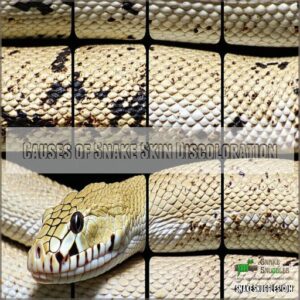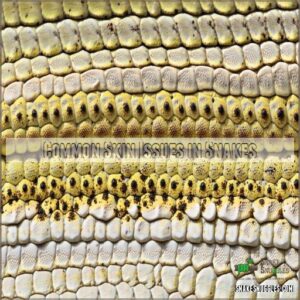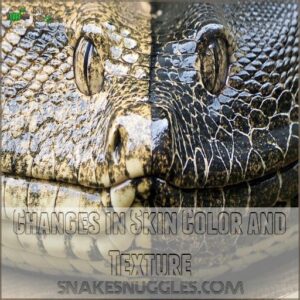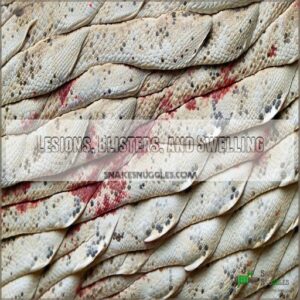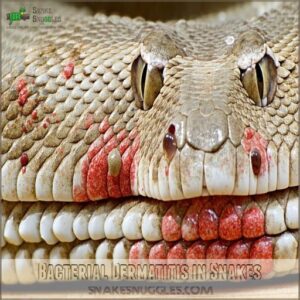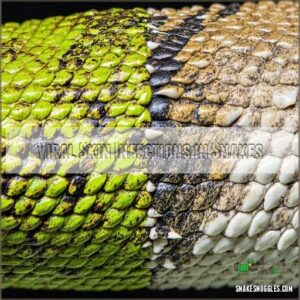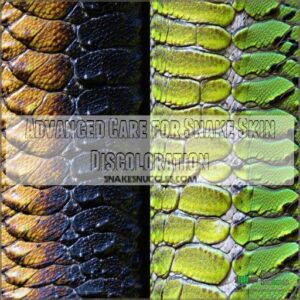This site is supported by our readers. We may earn a commission, at no cost to you, if you purchase through links.
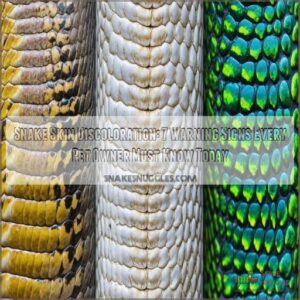
This common issue can signal various health concerns, from simple habitat problems to more serious infections.
Your snake’s skin might show unusual patterns, dull scales, or inflammation due to temperature fluctuations, nutritional deficiencies, or parasitic invasions.
With early detection, most skin conditions are highly treatable, boasting success rates of 70-85% with proper medical intervention.
Just like a snake needs the right conditions to shed its old skin, maintaining ideal habitat conditions and a balanced diet holds the key to preventing future complications.
Table Of Contents
- Key Takeaways
- Causes of Snake Skin Discoloration
- Symptoms of Snake Skin Discoloration
- Common Skin Conditions Affecting Snakes
- How to Recognize Snake Skin Discoloration
- Diagnosing Snake Skin Discoloration
- Treating Snake Skin Discoloration
- Preventing Snake Skin Discoloration
- Advanced Care for Snake Skin Discoloration
- Managing Snake Skin Discoloration
- Veterinary Care for Snake Skin Discoloration
- Frequently Asked Questions (FAQs)
- Why do Snake scales look discolored?
- How do you know if a snake has scale rot?
- Why do snakes shed red?
- Why do snakes blister?
- Do snakes have skin problems?
- Why does my snake smell so bad?
- What does snake skin rot look like?
- Why is my snake’s color fading?
- How to tell if your snake has scale rot?
- What causes skin to look like snake skin?
- Conclusion
Key Takeaways
- You’ll need to monitor your snake’s skin regularly for changes in color, texture, or unusual patterns—early detection leads to 70–85% treatment success rates.
- Your snake’s habitat conditions directly impact skin health—maintain proper temperature, humidity levels, and clean substrate to prevent bacterial and fungal infections.
- You can identify serious issues through specific symptoms—look for reddish patches, raised scales, blisters, or black spots that could indicate bacterial dermatitis, scale rot, or mite infestations.
- You shouldn’t wait to seek veterinary care if you notice skin abnormalities—proper diagnosis through cultures, PCR testing, or skin scrapings will determine the most effective treatment plan.
Causes of Snake Skin Discoloration
You’ll notice your snake’s skin changing color when problems like bacterial infections, poor habitat conditions, or nutritional deficiencies arise.
While some color changes happen during normal shedding, unexpected discoloration often signals health issues.
These issues need your attention, from simple environmental adjustments to more serious medical conditions requiring veterinary care.
Environmental Factors Affecting Skin Health
Your snake’s skin health hangs in the balance when environmental conditions aren’t just right. Snake skin discoloration often stems from habitat issues that you can easily fix.
Here are three critical factors that directly impact snake skin health:
- Temperature fluctuations beyond their comfort zone
- Humidity levels that aren’t matched to their species needs
- Poor ventilation combined with dirty substrate
Regular habitat maintenance and proper cleanliness are your best defense against these issues.
Nutritional Deficiencies and Skin Issues
Beyond environmental factors, diet plays a starring role in snake skin health issues. Poor nutrition can trigger snake skin discoloration and abnormal pigmentation.
Here’s what happens when key nutrients go missing:
| Deficiency | Impact on Skin | Warning Signs |
|---|---|---|
| Calcium | Incomplete shedding | Retained scales |
| Vitamin A | Pigment changes | Dull patches |
| Vitamin D3 | Scale abnormalities | Irregular texture |
Just like humans need a balanced diet, snakes require specific vitamins for best skin health.
Parasitic and Bacterial Infections
In the battle against snake skin discoloration, parasitic and bacterial infections** often lead the charge. These unwelcome guests can wreak havoc on your serpentine friend’s skin, causing visible changes that shouldn’t be ignored.
For instance, bacterial infections like Entamoeba invadens and Beneckea chitinovora can cause skin infections.
Here’s what to watch for:
- Mites appearing as tiny black dots, especially around eyes and scales
- Reddish-brown patches indicating bacterial dermatitis
- Scale lifting or separation from underlying tissue
- Small, raised bumps or pustules
- Unusual discharge or crusty areas
Skin Conditions and Diseases
Three severe skin conditions can trigger snake skin discoloration: scale rot from excessive moisture, deep-tissue abscesses from bacterial infections, and widespread lesions from fungal diseases.
Each condition manifests differently – scale rot appears as brown or black patches, abscesses form raised bumps with discharge, and fungal infections create white or yellow crusty areas.
Mite infestations can also cause reptile skin discoloration and patchy shedding issues.
Symptoms of Snake Skin Discoloration
You’ll notice changes in your snake’s skin through visible symptoms like unusual color patterns, scales that appear dull or discolored, and areas that show redness or inflammation.
Your snake might also develop concerning signs such as raised scales, blisters, or patches that feel rough to the touch, which can indicate various health issues requiring prompt veterinary attention.
visible symptoms
Common Skin Issues in Snakes
Through their scales, snakes reveal clues about their health. Abscesses appearing as raised lumps, or blister disease creating fluid-filled pockets are easily visible.
Scale rot often starts with brown spots, while mites leave tiny black specks between scales.
Snake skin discoloration might signal deeper issues, from nutritional gaps to infections.
Shedding problems, like retained skin patches, can indicate humidity troubles or underlying health concerns.
Changes in Skin Color and Texture
Detecting snake skin color change early can prevent serious health issues.
Watch for irregular scale discoloration, from sudden darkening to unexpected lightening.
Snake skin pigmentation shifts might signal an underlying illness or dietary impact. Healthy snakes display uniform coloring, while texture changes like dullness or roughness often accompany color variations.
Regular monitoring helps catch these warning signs before they worsen. Early detection is key.
Lesions, Blisters, and Swelling
Beyond color changes, watch for these physical symptoms that could signal serious health issues. Snake skin lesions, blisters, and swelling often indicate underlying problems requiring immediate attention. To address these issues, you can find snake skin lesion treatments and products online, such as those on websites dedicated to snake skin lesions care.
- Red, raised patches with defined edges suggest bacterial infection
- Fluid-filled blisters point to potential scale rot or burns
- Symmetrical swelling might indicate systemic infection
- Dark, crusty lesions could mean fungal disease
These abnormalities need prompt veterinary assessment to prevent complications.
Common Skin Conditions Affecting Snakes
You’ll need to watch for four major skin conditions that can affect your snake’s health: bacterial dermatitis, fungal disease, parasitic infections, and viral infections.
Each of these conditions shows distinct signs in your snake’s skin, from redness and swelling to unusual discoloration and scale abnormalities, which you’ll learn to identify and address properly.
Bacterial Dermatitis in Snakes
Inside your snake’s terrarium, bacterial dermatitis lurks as a silent threat that can quickly turn serious. You’ll notice reddish patches, unusual swelling, and flaky scales – early warning signs of this common skin infection.
Here’s what you need to know about preventing bacterial dermatitis and identifying symptoms:
| Symptom | Severity | Early Action | Treatment |
|---|---|---|---|
| Scale discoloration | Mild | Increase cleaning | Topical antibiotics |
| Raised scales | Moderate | Adjust humidity | Injectable antibiotics |
| Fluid-filled blisters | Severe | Isolate snake | Immediate vet care |
| Bleeding lesions | Critical | Emergency vet | Intensive treatment |
Snake Fungal Disease (SFD)
While bacterial infections can be serious, Snake Fungal Disease (SFD) presents an equally challenging threat.
This devastating condition, caused by Ophidiomyces ophiodiicola, primarily affects snakes in eastern U.S. regions.
Watch for telltale signs: thickened or crusty scales, unusual skin discoloration, and facial swelling.
Early SFD diagnosis is key – if you spot these symptoms, your snake needs immediate veterinary care.
SFD treatment typically involves specialized antifungal medications and careful habitat management.
Parasitic Skin Infections in Snakes
After managing fungal threats, you’ll need to watch for parasitic skin infections, another common cause of snake skin discoloration. Mites and ticks love making themselves at home on your pet’s scales.
Skin infections can also be bacterial or fungal in nature, and it’s important to detect them early for effective treatment – learn more about identifying snake skin problems.
Here’s what to check for:
- Red spots or unusual bumps around the eyes and mouth
- Excessive scratching against enclosure items
- Small black dots moving on light-colored scales
- Scale lifting or skin abnormalities near heat lamps
Viral Skin Infections in Snakes
Beyond parasites, viral skin infections pose a unique threat to your snake’s health.
These infections spread through direct contact or contaminated environments, causing distinct snake skin discoloration and lesions.
Your vet might recommend PCR testing to confirm the diagnosis.
Treatment typically includes antiviral treatments combined with immune support, while prevention strategies focus on isolation and strict hygiene protocols to protect your scaly friend from snake skin diseases.
How to Recognize Snake Skin Discoloration
You’ll notice changes in your snake’s skin through regular inspections, which can reveal early warning signs like unusual patches, blisters, or changes in color pattern.
When you check your snake’s skin each week, you’re looking for specific indicators that distinguish normal shedding from potential health issues.
potential health issues that need a vet’s attention.
Early Detection of Skin Problems
Anyone who’s kept snakes knows that proactive checks can make all the difference.
Your snake’s skin tells a story – subtle changes like darkening, lightening, or unusual patches often signal deeper health issues.
Catching snake skin discoloration early means quick action and better outcomes.
Think of skin abnormalities as your snake’s way of waving a red flag – the sooner you spot them, the easier they’re to treat.
Regular Skin Inspections and Checks
Set a weekly schedule for thorough snake skin inspections – it’s your best defense against health issues.
For a visual guide to common discolorations, you might find a helpful snake skin discoloration chart useful.
Check every scale carefully, paying special attention to belly scales and the area around the cloaca.
Keep detailed records of any snake skin abnormalities you spot, including photos for tracking changes over time.
Regular vet visits combined with consistent inspection frequency create a solid foundation for catching problems early.
Identifying Changes in Skin Color and Texture
Regular skin inspections reveal subtle changes in your snake’s appearance.
Watch for snake skin darkening or lightening, especially if it occurs in patches. Unusual blotches, raised scales, or rough texture changes might signal health issues.
During shedding, look for abnormalities like retained skin or lesions.
Snake skin discoloration patterns, from reddish spots to gray patches, can indicate different problems – some minor, others requiring immediate vet attention.
Diagnosing Snake Skin Discoloration
You’ll need to examine your snake’s skin for specific signs that point to bacterial, fungal, or parasitic infections, which can include redness, unusual scales, or discolored patches.
Testing methods like skin swabs, biopsies, and blood work will help your veterinarian determine the exact cause of your snake’s skin condition and create an effective treatment plan.
Diagnostic Methods for Bacterial Infections
Once you’ve spotted unusual changes in your snake’s skin, your vet will need precise diagnostic methods to pinpoint bacterial infections.
- Take bacterial cultures from affected areas to identify specific pathogens
- Perform Gram staining to classify bacteria types
- Run microscopic exams of skin samples for detailed analysis
- Conduct antibiotic sensitivity tests to determine the most effective treatment
These tests help create a targeted treatment plan for your snake’s skin discoloration or bacterial dermatitis.
Diagnostic Techniques for Fungal and Viral Infections
Accurate diagnosis of snake fungal disease and viral skin infections requires a multi-step approach.
Your vet will likely start with PCR testing to identify specific pathogens, followed by biopsy analysis to examine tissue samples.
Serological tests help detect antibodies, while virus isolation confirms active infections.
For antifungal efficacy testing, they’ll take cultures to determine the most effective treatment, especially when dealing with resistant strains.
Identifying Parasitic Skin Infections
While fungal and viral tests take time, parasitic skin infections show immediate visual clues.
You’ll spot mites as tiny black dots moving across your snake’s scales, which can cause a range of issues including blood loss from mite infestations.
For accurate parasite diagnosis, your vet might perform a skin scraping or use a special UV to identify specific types of snake skin parasites and determine appropriate treatment options.
Treating Snake Skin Discoloration
You’ll find effective treatments for your snake’s skin discoloration through a combination of targeted medications and environmental adjustments based on the underlying cause.
Whether you’re dealing with bacterial infections requiring antibiotics or fungal issues needing antifungal medications, your veterinarian can create a customized treatment plan that addresses both the immediate symptoms and long-term prevention.
Antibiotic Treatment for Bacterial Infections
Successfully treating snake skin bacterial infections requires a targeted antibiotic approach.
Your vet will prescribe specific antibiotic types based on bacterial cultures, with common options including enrofloxacin or ceftazidime. Treatment duration typically spans 7-14 days, with dosage amounts carefully calculated by weight.
While success rates exceed 80% when caught early, watch for side effects like reduced appetite or lethargy during the treatment course.
Antifungal Treatment for Fungal Infections
Antifungal treatment for snake skin fungus requires a precise approach. You’ll need to apply prescription antifungal medications directly to affected areas twice daily.
Snake fungal disease (SFD) treatment typically spans 2-4 weeks, with efficacy rates varying between 70-85%.
Systemic antifungals might be necessary for severe cases, but watch for side effects like reduced appetite.
Prevention strategies include maintaining ideal humidity and avoiding overhandling during treatment.
Treatment Options for Viral Skin Infections
Treating viral skin infections in snakes requires a targeted approach based on PCR testing and virus identification.
When your snake shows signs of skin discoloration, you’ll need to:
- Start antiviral medications prescribed by your vet
- Boost immune support through temperature management
- Follow strict isolation protocols to prevent spread
Remember, snake skin conditions caused by viruses often need longer treatment periods than bacterial infections. Your vet might adjust treatments based on how your snake responds.
Medications for Parasitic Skin Infections
When parasites take hold, specific medications target different invaders.
For mite and tick infestations, your vet might prescribe medicated dips containing ivermectin or fipronil, and knowing how to treat snake mites can also be beneficial.
These treatments work best when combined with preventative measures like habitat cleaning.
Watch for side effects during treatment – if your snake shows unusual behavior or loss of appetite, contact your vet immediately.
Remember, proper dosage is key to effective parasite control.
Preventing Snake Skin Discoloration
You’ll discover that preventing snake skin discoloration begins with creating ideal habitat conditions, including proper temperature gradients and humidity levels monitored by a hygrometer.
Maintaining your snake’s health also requires a balanced diet with appropriate prey size, along with regular veterinary checkups to catch any potential skin issues before they become serious problems.
Creating a Healthy Habitat for Snakes
Your snake’s home can make or break their skin health. Setting up the right reptile habitat prevents those dreaded skin problems and keeps your scaly friend thriving.
Here’s what your setup needs:
- Perfect substrate choices: Use aspen shavings or cypress mulch, never wire mesh
- Spot-on temperature control: Maintain 75-85°F with proper basking spots
- Balanced humidity levels: Keep 50-70% using a reliable hygrometer
Don’t forget regular habitat cleaning to prevent bacterial growth.
Providing a Balanced Diet for Snakes
Proper nutrition plays a direct role in preventing snake skin discoloration and other health problems.
A balanced diet requires careful attention to prey variety and prey size, matching your snake’s specific dietary needs.
Consider supplement use, particularly calcium and vitamin A, which directly impact skin health. Regular monitoring helps identify nutritional deficiencies before they manifest as snake skin conditions, keeping your pet’s scales healthy and vibrant. Proper nutrition and supplement use are key.
Safe Prey and Feeding Frequency
Beyond balanced nutrition, prey size and feeding schedules play a direct role in preventing snake skin discoloration.
Feed appropriately-sized prey – no larger than 1.5 times your snake’s mid-body width – to prevent stress and skin damage.
Space feedings every 7-14 days for adults, adjusting based on species and activity levels. Live prey can bite and scratch, causing infections, so opt for pre-killed options. Prey size and feeding schedules are important.
Regular Veterinary Checkups and Assessments
Regular checkups with an experienced reptile vet form the backbone of preventative care for snake skin discoloration. Schedule visits every 6 months to catch potential issues before they worsen.
During these assessments, your vet will perform thorough skin examinations for early detection, check for parasites and bacterial infections, and monitor weight and overall health trends.
You can also support these checkups by maintaining a regular snake health check routine at home, utilizing resources like a snake health check kit.
Your vet will review your husbandry practices and suggest improvements.
These proactive steps greatly reduce the risk of serious snake health problems developing over time.
Advanced Care for Snake Skin Discoloration
When your snake’s skin condition hasn’t improved with basic treatments, you’ll need to explore advanced care options.
including specialized medications, surgical procedures, and experimental therapies.
Your veterinarian can guide you through sophisticated treatment plans.
that target severe bacterial infections, resistant fungal diseases, and complex parasitic conditions requiring more intensive intervention.
Advanced Treatment Options for Skin Issues
When traditional treatments fail to address severe snake skin discoloration, advanced therapies step in.
Your vet might recommend plasma therapy to boost healing or innovative phototherapy sessions to target bacterial dermatitis.
For persistent viral skin infections, immunotherapy and stem cell treatments show promising results.
These cutting-edge options, though typically more expensive, can be game-changers when standard treatments fall short.
Surgical Interventions for Skin Problems
Surgical interventions for snake skin problems sometimes become necessary when conservative treatments fail. From minor incisions to complex procedures, veterinary surgeons tackle severe cases of snake skin disease through specialized techniques.
- Necrotic tissue removal prevents infection spread and promotes healing
- Advanced wound closure methods seal damaged areas effectively
- Skin grafting techniques repair extensive lesions
- Post-op care includes specialized bandaging and monitoring
Experimental Treatments for Snake Skin Conditions
Beyond traditional treatments, emerging research offers promising novel therapies for stubborn snake skin conditions, often caused by underlying issues such as skin infections and dermatitis.
Let’s explore cutting-edge options that show potential:
| Treatment Type | Application Method | Success Rate |
|---|---|---|
| Photodynamic Therapy | Light-activated drugs | 75% |
| Stem Cell Solutions | Direct injection | 65% |
| Nanoparticle Delivery | Topical application | 80% |
Clinical trials testing innovative solutions for bacterial dermatitis and viral skin infections suggest these methods could revolutionize treatment of snake skin discoloration.
Current research focuses on targeted drug delivery systems and precision medicine approaches.
Managing Snake Skin Discoloration
You’ll need to isolate your snake in a clean, separate enclosure while managing its skin discoloration to prevent stress and potential complications during recovery.
During this time, you’ll want to maintain precise temperature and humidity levels.
while thoroughly disinfecting your snake’s main habitat, ensuring it’s ready for your pet’s return to peak health.
Isolating The Snake for Recovery
Quarantine protocols play a key role in your snake’s healing journey.
Set up a recovery enclosure away from other reptiles to prevent disease spread.
Keep stress reduction in mind by maintaining proper temperature and humidity levels. While monitoring progress of snake skin discoloration, watch for improved shedding and color.
Once your pet meets release criteria – typically showing clear skin and normal behavior – they can return home. release criteria
Habitat Cleaning and Disinfection
Regular habitat cleaning and disinfection are your first line of defense against snake skin discoloration.
When maintaining your reptile habitat, follow these essential hygiene practices:
- Remove waste daily and spot-clean soiled substrate immediately
- Deep clean the entire enclosure weekly using reptile-safe cleaning products
- Replace substrate monthly or when visibly soiled, choosing materials that won’t trap moisture
Always rinse thoroughly and let surfaces dry completely before returning your snake.
Providing a Stress-Free Environment
During recovery from snake skin blotches and infections, creating a stress-free habitat is essential.
Position the secure enclosure in a quiet location away from high-traffic areas and loud noises.
Provide multiple hiding places using cork bark or reptile caves to help prevent snake shedding problems.
Maintain proper temperature control and add habitat enrichment like climbing branches – your snake will thank you with healthier skin and better recovery rates.
Veterinary Care for Snake Skin Discoloration
When faced with snake skin discoloration, swift veterinary intervention can make all the difference between recovery and complications.
Your vet will typically start with diagnostic tests, including skin scrapings and blood work, to pinpoint the exact cause.
For bacterial or fungal snake skin infections, they’ll prescribe targeted medications, while parasitic issues might require special dips or oral treatments.
Emergency protocols kick in for severe cases, where your snake might need immediate care to prevent systemic spread.
Most snake skin conditions respond well to early treatment, but some complex cases may need specialist referrals to exotic pet veterinarians.
Preventative care through regular check-ups helps catch potential problems before they escalate. Your vet can also guide you on proper habitat maintenance and nutrition to minimize future skin issues – think of it as insurance for your scaly friend’s health.
Frequently Asked Questions (FAQs)
Why do Snake scales look discolored?
While you might think it’s always concerning, snake scale discoloration often occurs naturally during shedding.
However, it can also indicate health issues like infections, parasites, or improper habitat conditions that need attention.
How do you know if a snake has scale rot?
Look for brown or reddish patches on your snake’s belly or sides.
You’ll notice blisters, open sores, or softened scales that feel mushy to touch.
These signs typically appear in areas with excessive moisture.
Why do snakes shed red?
Red-tinted shedding occurs in snakes due to increased blood flow to their skin during the shedding process.
Your snake’s blood vessels become more visible as they expand to aid skin separation and renewal.
Why do snakes blister?
Consider the case of a corn snake exposed to excessive moisture: Your snake may develop blisters when their habitat’s too wet or dirty.
Blister disease happens from bacteria growth, requiring daily cleaning and antibiotics for treatment.
Do snakes have skin problems?
Yes, snakes experience various skin issues like bacterial infections, parasites, and shedding problems. They’ll need proper care including clean habitats, correct humidity, and sometimes vet visits to maintain healthy skin.
Why does my snake smell so bad?
Bad odors from your snake often indicate infectious stomatitis (mouth rot) or accumulated waste.
Check for gum bleeding, mucus buildup, and clean the enclosure regularly.
A vet visit’s needed if the smell persists.
What does snake skin rot look like?
Your snake’s skin may look like melted wax, with reddish-brown patches and raised, blistered scales.
The affected areas can appear moist, discolored, and have an unpleasant odor similar to rotting vegetation.
Why is my snake’s color fading?
Snake color fading often signals an upcoming shed.
It can also indicate poor nutrition, inadequate lighting, or underlying health issues.
Monitor temperature and humidity levels while ensuring a balanced diet of properly-sized prey.
How to tell if your snake has scale rot?
Watch for discolored, blistered, or raised scales on the belly – these indicate scale rot.
Other signs include redness between scales, a foul smell, and abnormal behavior like lethargy.
Immediate veterinary care is essential.
What causes skin to look like snake skin?
Several conditions can make skin look scaly: psoriasis, eczema, ichthyosis, or severe dehydration.
Sometimes medications or genetic factors cause this pattern.
Sun damage and aging may create a similar textured appearance.
Conclusion
Like a vigilant guardian watching over precious scales, you’re now equipped to spot and address snake skin discoloration before it becomes serious.
Remember that prevention through proper habitat maintenance and diet is your best defense.
If you notice any concerning changes, don’t wait – consult your exotic vet promptly.
With the knowledge you’ve gained and proper veterinary care, you can guarantee your serpentine companion maintains healthy, vibrant skin for years to come.

